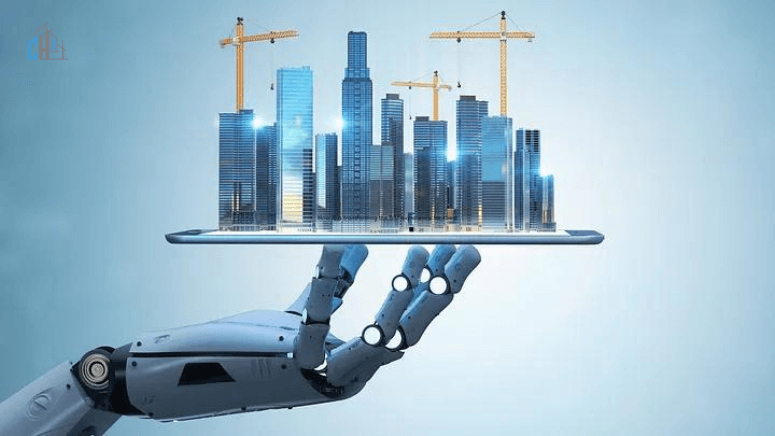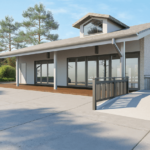Artificial Intelligence (AI) integrated with Building Information Modeling (BIM) is revolutionizing residential construction. This blend enhances efficiency, precision, and sustainability in building practices.
Building the Future How AI BIM Modeling is Transforming Residential Construction
AI with BIM is the new trend in the construction of residential buildings. This combination improves productivity, accuracy, and the sustainability of construction processes.
The construction industry is standing at the precipice of change and it is driven by Artificial Intelligence (AI) and Building Information Modeling (BIM). This technological advancement is essential for you if you are an architect, construction firm, or engineer.
In this blog post, we will discuss how the use of AI BIM modeling is changing the construction of residential buildings. From enhancing efficiency to cutting costs, AI BIM is revolutionalizing the construction of homes.
This paper will discuss the history of residential construction, advantages of AI BIM, examples of its use, difficulties of implementation, and prospects. Prepare to learn how this revolutionary technology can transform your work on residential projects.
The Evolution of Residential Construction
People usually understand construction involve a lot of manual work but over these decades construction involving housing in particular has advanced in a way that entails more organizational and innovative techniques.
Traditional Approaches
What was more, until the mid-2000s, residential construction utilized manual procedures and simple applications for planning.
Specialists that would create blueprints include designers, while calibration of the strength would involve the engineering profession, and the construction of the actual structure would involve construction-related corporations. As efficient as they were, such methods proved to be rather lengthy and frequently involved mistakes and misunderstandings.
Enter BIM
The application of Building Information Modeling or BIM, came into the scene as a revolution in the early part of the twenty-first century. It facilitated generation of models that included architectural, structural as well as MEP – Mechanical, Electrical & Plumbing models.
It also helped in visualisation, coordination and management of projects by shifting the perception of the employees. But, nevertheless, even BIM was insufficient for some applications, for example, when working with large amounts of data or implementing predictive analysis.
AI as Applied to BIM
This is where AI comes into the scene, and into the future. AI complementary to BIM improves performance in data analysis, modeling, forecasting, and decision support. By utilizing big data, AI algorithms will be able to work through a massive amount of information to alleviate design and construction scheduling as well as resource management.
This conjunction of the AI and BIM is creating the groundwork for the following generations of residential constructions.
Benefits of AI BIM in Residential Construction
The adoption of BIM in residential construction brings numerous benefits, including:
Improved Efficiency
Efficacy is probably the biggest advantage that can be attributed to the use of AI BIM modeling. Conventional approaches are normally very tedious and more often than not, the activities are usually carried out manually.
These and many other jobs can be done by AI, thus saving Architects and engineers precious time. For instance, it may provide unique options concerning a particular design specification and may take lesser time for decision making.
Cost Savings
This is normally reached by overheating the cost slated for the project thus making it uncontrollable to contain the escalation of costs particularly within home construction projects. This is overcome in AI BIM modeling by making cost estimations as well as identifying the some risks that may arise in a project.
Due to the proper utilization of resources and efficient elimination of wastage, AI BIM can also help in saving a considerable amount of money. Besides, whenever used in predictive maintenance, artificial intelligence is capable of increasing the durability of building material, therefore, lowering overall cost in the future.
Enhanced Collaboration
AI BIM enhance all the stakeholders’ interaction. Having everyone working from one centralized data established minimizes instances where someone is not informed or not fully informed of the status.
Synchronization with any improvements and extension of the cloud environment also helps to eliminate the possibility of a communication breakdown even when the team members are located in different parts of the world. This creates greater synergism, and in turn, a better project flow and, thus, superior results from the given project.
Improved Project Outcomes
In the end, every construction project aims at providing a well-done, durable, beautiful structure that will serve as a building. AI BIM modeling enhances the efficiency of undertaking a project hence leading to enhanced project work performance.
For instance, if it was used in analyzing environmental data it can suggest appropriate building materials and designs that are precocious to the environment. This serves not only the end-users’ needs but is also eco-friendly concerning the construction sector.
Challenges and Adoption of AI BIM
However, the use of AI BIM in the residential construction was not without some difficulties. Some of these are non-recurring expenses such as installation costs, qualified workforce, and people’s relentlessness to new ideas.
Technological Barriers
However, the use of AI BIM modeling has some hurdles that are worth to be noted. Perhaps one of the biggest challenges that has to be overcome is the technological factor where organizations must learn how to adapt to certain technologies.
AI remains an unfamiliar concept to many employees in this sector and for many of them AI can be described as something new, trendy and unknown. This actually hinders the progress of adoption due to lack of such expertise.
Financial Constraints
The use of AI BIM in operations calls for a considerable amount of communication spending in terms of the resources, as well as employee training.
In the case of SMMs, they may experience difficulties allocated the necessary amount of resources. At the same time, the long-term advantages result from the initial investments, which is why progressive organizations should focus on such solutions.
Resistance to Change
As with most things in life, change is often threatened and the construction industry is no different. It is possible that professionals may be exhibiting such a reaction because of the fear of job loss as well as doubts on the capability of the AI algorithms used in AI BIM.
Thus, the key to overcoming this form of resistance is education and training where the benefits of incorporating AI BIM can be clearly shown.
Strategies for Overcoming Challenges
For organisations to fully implement AI BIM, there is need to incorporate relevant training to ensure the human resource is sufficiently inducted with the all new progra.
Such collaboration can also mitigate the challenges since technology providers are knowledgeable of the changes. Also, beginning with demonstration projects can yield most information and establish faith in the new technology at the same time.
The Future of AI BIM in Residential Construction
The future of AI BIM in residential construction looks promising. As technology continues to evolve, we can expect even more advanced applications of AI in the construction industry.
Predictive Analytics
The future of AI BIM holds exciting possibilities. Predictive analytics powered by AI will become increasingly sophisticated, allowing for more accurate forecasting of project timelines, costs, and potential risks. This will enable firms to make data-driven decisions and improve project outcomes.
Integration with Smart Technologies
AI BIM will also integrate more seamlessly with other smart technologies. For example, IoT (Internet of Things) sensors can provide real-time data on construction sites, which AI can analyze to optimize resource allocation and ensure safety. This convergence of technologies will lead to smarter, more efficient construction processes.
Greater Focus on Sustainability
Sustainability will continue to be a driving force in the construction industry. AI BIM will play a crucial role in achieving sustainability goals by recommending eco-friendly materials, optimizing energy usage, and minimizing waste. Future residential projects will increasingly prioritize green building practices, driven by AI-powered insights.
Expanding Use Cases
While currently focused on design and construction, the applications of AI BIM will expand to other areas such as facility management and building maintenance. AI algorithms can predict when maintenance is needed, reducing downtime and extending the lifespan of buildings. This holistic approach will revolutionize the entire lifecycle of residential buildings.
Global Adoption
As AI BIM technology becomes more accessible and affordable, its adoption will spread globally. Emerging markets will particularly benefit from the efficiencies and cost savings offered by AI BIM. This global expansion will lead to a more connected and innovative construction industry.
How CAD Drafting Services Company Can Your BIM Residential Construction Projects
CAD (Computer-Aided Design) drafting services are essential for the successful implementation of AI BIM in residential construction projects. Elevate your construction projects by hiring expert BIM modelers. Using specialized software, these services create detailed 2D and 3D models, which serve as a foundation for BIM modeling.
Improved Accuracy
CAD drafting significantly improves the accuracy of BIM models by providing precise measurements and bim dimensions. This is essential for ensuring that all elements fit together seamlessly during construction.
Faster Turnaround Time
The speed and efficiency of CAD drafting services allow for faster project completion and quicker revisions when necessary. This minimizes delays and keeps projects on track.
Cost Savings
By leveraging CAD drafting services, firms can save on equipment and software costs as well as labor expenses. This is particularly beneficial for smaller firms that may not have the resources to invest in their own drafting department.
Conclusion
In conclusion, AI BIM modeling is transforming residential construction in unprecedented ways. From improving efficiency and reducing costs to enhancing collaboration and project outcomes, the benefits are clear.
However, the adoption of this technology comes with challenges that must be addressed through education, training, and strategic planning. The future of AI BIM in residential construction is bright, with endless possibilities for innovation and sustainability.




